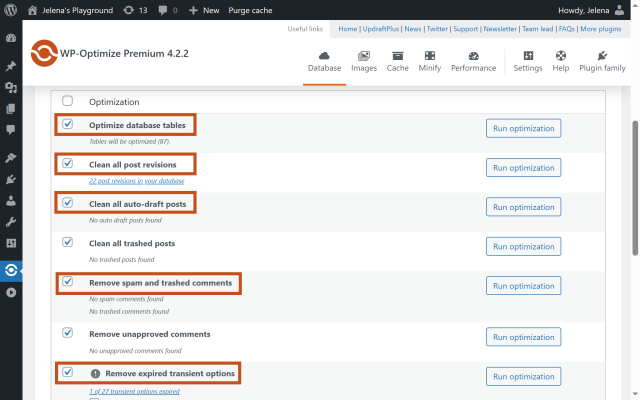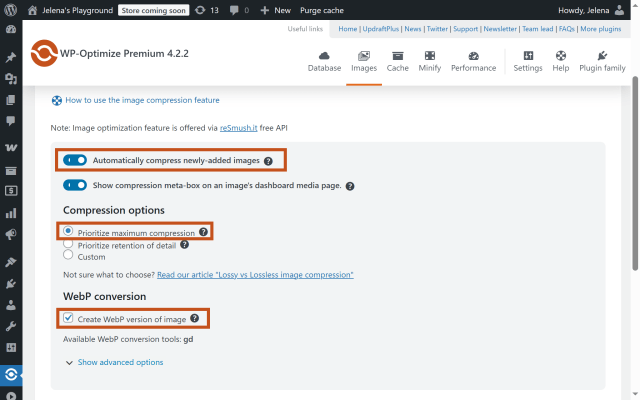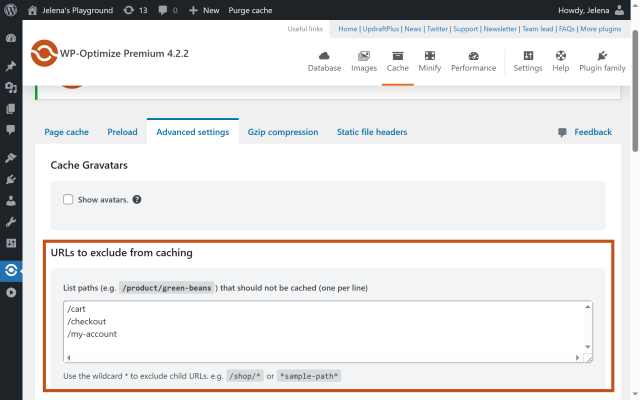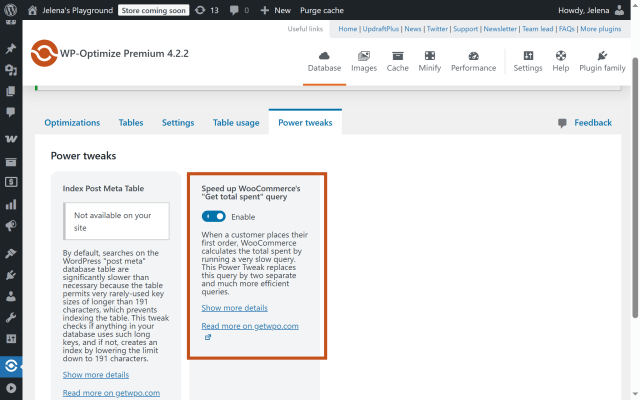How to speed up your WooCommerce site
If you’re running a WooCommerce store, you already know that speed matters. A slow-loading site means frustrated visitors, abandoned carts and lost sales. In the competitive world of eCommerce, every second counts.
The good news? You can speed up WooCommerce without needing to be a developer. With a few practical steps, and the right tools, you can significantly boost your store’s performance, improve customer experience, and increase conversions.
Let’s break down exactly how to do that.
Key takeaways
Section titled Key takeaways- Clean up database bloat that slows down WooCommerce sites
- Compress large product images to improve mobile and desktop speed
- Optimize cart and checkout performance for higher conversions
- Reduce plugin conflicts and bloat with smart audits
- Choose lightweight, fast-loading WooCommerce themes
- Use WP-Optimize to simplify database, image, and caching improvements
1. Clean Up WooCommerce Database bloat
Section titled 1. Clean Up WooCommerce Database bloatWooCommerce stores generate a lot of behind-the-scenes clutter: post revisions, expired transients, orphaned meta data, and abandoned cart sessions all add up. Over time, this bloat makes database queries slower, especially on high-traffic stores.
Quick fix
Section titled Quick fixUse WP-Optimize to clean and optimize your database safely.
It helps you:
- Remove unnecessary post revisions
- Clear expired transients
- Delete spam/trashed comments
- Optimize database tables
How to do it
1. Install and activate WP-Optimize
2. Go to WP-Optimize > Database in your WordPress dashboard
3. Check the following boxes:
- Clean all post revisions (removes older versions of edited posts and pages)
- Clean all auto-draft posts (removes drafts WordPress auto-saves that were never published)
- Remove spam and trashed comments (clears out comments marked as spam or moved to trash)
- Remove expired transient options (deletes temporary cached data that’s no longer needed)
- Optimize database tables (repairs and defragments tables for improved speed and efficiency)
4. Click “Run all selected optimizations”

These safe, one-click cleanups can dramatically reduce database overhead and help your WooCommerce store run faster, especially during high-traffic periods.
2. Compress product images without losing quality
Section titled 2. Compress product images without losing qualityLarge product images are a major cause of slow WooCommerce pages, particularly on mobile. Uncompressed media increases load time and hurts conversions.
Quick fix
Section titled Quick fixUse WP-Optimize’s Image Compression feature to reduce file size while maintaining image clarity.
How to do it
- Go to WP-Optimize > Images
- Choose your preferred compression level:
- Prioritize maximum compression (smallest file size, slight quality reduction)
- Prioritize retention of detail (best image clarity, less compression)
- Custom (manually adjust the balance between compression and quality)
- Click “Compress the selected images” to bulk compress selected images
- Enable “Automatically compress newly-added images” to keep things optimized moving forward
- For the best performance, select “Create WebP version of the image“

This makes product pages load faster and keeps your store mobile-friendly.
3. Speed up the cart and checkout experience
Section titled 3. Speed up the cart and checkout experienceCart and checkout pages are critical for conversions – but they’re also some of the slowest parts of a WooCommerce site due to dynamic content and payment scripts.
What you can do in WP-Optimize
Section titled What you can do in WP-OptimizeWhile cart and checkout pages shouldn’t be cached, you can use WP-Optimize to speed up the rest of your site, indirectly improving the overall experience.
Enable Page Caching (with exclusions):
- Go to WP-Optimize > Cache
- Enable Page Caching
- Under the Advanced settings tab, make sure these URLs are excluded:
- /cart
- /checkout
- /my-account

Note: These URLs can vary depending on your WooCommerce settings or customizations. Double-check your actual page slugs under Pages > All Pages to confirm the correct paths.
This ensures category and product pages load faster, while checkout remains functional and secure.
4. Limit plugin conflicts and bloat
Section titled 4. Limit plugin conflicts and bloatWhile plugins are essential for functionality, too many, or poorly built ones, can harm performance. Some load scripts on every page, even when not needed.
Quick fixes
Section titled Quick fixes- Audit your plugins: Deactivate and delete ones you don’t need
Use a script manager: Tools like Asset CleanUp or Perfmatters help you disable scripts site-wide or on specific pages - Stick to WooCommerce-compatible plugins known for performance
- Run Optimization from one place when possible: Instead of stitching together 5+ different performance tools, WP-Optimize offers multiple features in one lightweight package: caching, database cleaning, minification, image compression, and more, all built to reduce plugin clutter and maximize compatibility.
By keeping your plugin stack lean, fast, and conflict-free, you’ll improve load times, reduce errors, and deliver a smoother shopping experience, without sacrificing features.
5. Choose a fast, WooCommerce-Optimized theme
Section titled 5. Choose a fast, WooCommerce-Optimized themeYour theme is the base layer of your store’s speed. If it’s bloated or poorly coded, all other optimizations will be limited.
Quick fix
Section titled Quick fixChoose a lightweight, performance-focused theme built for WooCommerce, such as:
- Astra
- GeneratePress
- Storefront (official WooCommerce theme)
These themes are designed to be fast out-of-the-box and pair well with WP-Optimize for additional gains.
6. Optimize customer Total Spent calculation
Section titled 6. Optimize customer Total Spent calculationWooCommerce stores with a large number of customers and orders can suffer performance issues due to how customer purchase history is calculated. Specifically, when a customer places their first order, WooCommerce runs a single, very slow query to calculate the “total spent” value.
This is where WP-Optimize Premium comes in with one of its Power Tweaks, a feature built to fix inefficiencies WooCommerce hasn’t yet addressed.
What this Power Tweak does
Section titled What this Power Tweak does- Replaces WooCommerce’s single slow query with two faster, more efficient queries
- Optimizes performance on stores with large customer and order volumes
How to do It
- Upgrade to WP-Optimize Premium: This feature is only available in the premium version of the plugin.
- Go to WP-Optimize > Database > Power Tweaks
- Enable the “Speed up WooCommerce’s “Get total spent” query” Option

For stores handling thousands of customers and orders, this single tweak can lead to noticeable performance improvements – especially during busy sales periods or when processing multiple checkouts at once.
Why speeding up WooCommerce matters
Section titled Why speeding up WooCommerce mattersA fast WooCommerce store isn’t just about performance, it directly affects your bottom line.
Faster load times reduce bounce rates: Visitors leave if pages take too long
Speed improves conversions: A smoother checkout means more completed purchases
Google rewards speed: Site speed is a known SEO ranking factor
Mobile users expect speed: On mobile, slow equals lost sales
In short, speed builds trust, improves usability, and drives revenue.
With the right strategies and tools, you’re not just making your store faster. You’re making it more competitive, more reliable, and more profitable.
Speed up your WooCommerce store the smart way
WP-Optimize combines database cleanup, image compression, and page caching, all in one plugin that’s easy to set up and safe to use.
- No coding required
- Made for WordPress + WooCommerce
- Improves speed site-wide
FAQs
Section titled FAQsWhy is my WooCommerce website so slow?
A slow WooCommerce site is usually caused by unoptimized images, excessive database bloat, too many plugins, or a poorly coded theme. Hosting quality and lack of caching can also play a major role.
What is the best plugin to speed up WooCommerce?
WP-Optimize is one of the best plugins to speed up WooCommerce. It combines caching, image compression, database cleaning, and performance tweaks, all in one lightweight tool.
How do I speed up WooCommerce API?
To speed up the WooCommerce API, minimize calls, cache responses when possible, and reduce backend load by optimizing your database and disabling unused REST endpoints.
What is the fastest hosting for WooCommerce?
Managed WooCommerce hosting providers like Kinsta, SiteGround, and Cloudways are known for speed, scalability, and support. Choose one that offers SSD storage, server-side caching, and optimized PHP performance.
Will speeding up WooCommerce improve SEO?
Yes. Faster WooCommerce sites improve user experience, reduce bounce rates, and meet Core Web Vitals – all of which positively affect your SEO and Google rankings.
About the author

Jelena Janić
Jelena is the Product Manager for UpdraftPlus and WP-Optimize. With seven years of experience, she’s taken on many roles – from tester to developer and now product manager. Along the way, she noticed a disconnect between how products are built and what customers need, sparking a passion for steering products toward solutions that truly serve the people who use them. Today, she ensures every WP-Optimize development decision is geared toward boosting WordPress website performance, enhancing usability, and increasing customer satisfaction.
Categories
WP-Optimize
Get all our premium features. Lazy loading, pre-load key requests, Cloudfare integration. Optimize individual tables, delete unused images and more.
From just $49 for the year.
More stories
-

Best WordPress themes for affiliate marketing sites
Find the fastest, most flexible themes built to grow your affiliate site in 2026.
-

How to track your website traffic without cookies
Learn how cookie-free analytics works, why it matters for privacy, and how to set it up on WordPress using modern, privacy-friendly tools.
-

How to block a country in WordPress
Learn how to block a country in WordPress safely using AIOS, .htaccess rules, or CDN firewalls. Learn the best methods to protect your site without harming SEO.
-

Best spam protection plugins for WordPress
This guide compares the best WordPress spam protection plugins to help you block bots, protect discussions, and keep your site clean.
